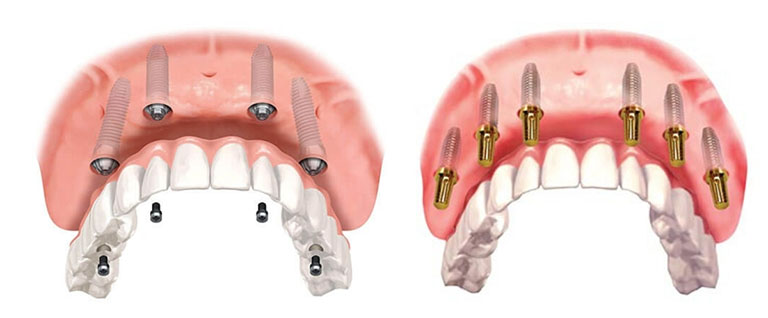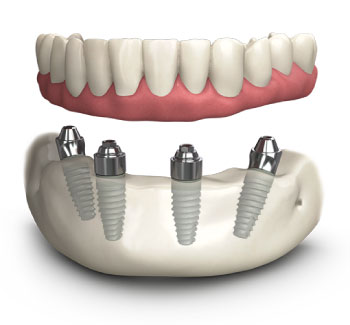Understanding the Differences: All-on-4 vs All-on-6 Dental Implants
Dental implants have revolutionized the field of restorative dentistry, providing patients with a long-lasting solution to missing teeth. Among the various options available, All-on-4 and All-on-6 dental implants have gained significant popularity. Both procedures offer a fixed set of teeth that are supported by dental implants, but they differ in terms of the number of implants used and the resulting benefits. In this article, we will delve into the details of All-on-4 and All-on-6 dental implants, highlighting their differences and helping you make an informed decision.
>>> https://platinumdentalvietnam.com/all-on-4-and-all-on-6-dental-implants/

All-on-4 Dental Implants
All-on-4 dental implants are a revolutionary technique that allows for the placement of a full arch of teeth using only four dental implants. This procedure is designed to provide a stable and functional set of teeth, even for patients with limited bone volume. The implants are strategically placed in areas of the jaw where the bone density is highest, maximizing support and stability.
One of the major advantages of All-on-4 implants is that they offer a quicker treatment timeline compared to traditional implant-supported dentures. With All-on-4, it is often possible to extract any remaining teeth, place the implants, and attach a temporary set of teeth, all in a single day. This immediate loading feature allows patients to leave the dental office with a functional smile, minimizing the waiting time and enhancing the overall experience.
However, it is important to note that All-on-4 implants rely on only four implants to support a full arch of teeth. While this technique has been successful for many patients, it may not be suitable for individuals with compromised bone density or those who require additional support for their prosthetic teeth.
All-on-6 Dental Implants
All-on-6 dental implants, as the name suggests, involve the placement of six dental implants to support a full set of teeth. This technique offers increased stability, especially for patients with a greater need for support due to bone loss or a larger arch size. The additional implants distribute the biting forces more evenly, reducing the strain on individual implants and improving the long-term success of the restoration.
With All-on-6 implants, the treatment process may take slightly longer compared to All-on-4. The additional implants require careful planning and precise placement, ensuring optimal support and aesthetics. However, this additional time investment can lead to a more secure and durable solution.
Furthermore, All-on-6 implants provide a higher level of flexibility in terms of prosthetic design. With six implants, the restoration can be customized to achieve a more natural and lifelike appearance, enhancing both the function and aesthetics of the final result.

Choosing the Right Option
When deciding between All-on-4 and All-on-6 dental implants, it is crucial to consult with an experienced dental professional. They will evaluate your specific needs, including bone density and arch size, to determine the most suitable treatment option for you.
Ultimately, both All-on-4 and All-on-6 dental implants offer significant benefits over traditional dentures, providing a fixed and stable set of teeth. The choice between the two depends on individual factors, such as bone density, arch size, and personal preferences. By understanding the differences between these techniques, you can work together with your dentist to choose the option that will provide you with the best long-term outcome.
In conclusion, All-on-4 and All-on-6 dental implants are advanced solutions for restoring missing teeth. They differ in the number of implants used and the resulting benefits. By exploring these differences and consulting with your dentist, you can make an informed decision that will help you regain a confident smile and optimal oral function.
Dental implants have revolutionized the field of restorative dentistry, providing patients with a long-lasting solution to missing teeth. Among the various options available, All-on-4 and All-on-6 dental implants have gained significant popularity. Both procedures offer a fixed set of teeth that are supported by dental implants, but they differ in terms of the number of implants used and the resulting benefits. In this article, we will delve into the details of All-on-4 and All-on-6 dental implants, highlighting their differences and helping you make an informed decision.
>>> https://platinumdentalvietnam.com/all-on-4-and-all-on-6-dental-implants/

All-on-4 Dental Implants
All-on-4 dental implants are a revolutionary technique that allows for the placement of a full arch of teeth using only four dental implants. This procedure is designed to provide a stable and functional set of teeth, even for patients with limited bone volume. The implants are strategically placed in areas of the jaw where the bone density is highest, maximizing support and stability.
One of the major advantages of All-on-4 implants is that they offer a quicker treatment timeline compared to traditional implant-supported dentures. With All-on-4, it is often possible to extract any remaining teeth, place the implants, and attach a temporary set of teeth, all in a single day. This immediate loading feature allows patients to leave the dental office with a functional smile, minimizing the waiting time and enhancing the overall experience.
However, it is important to note that All-on-4 implants rely on only four implants to support a full arch of teeth. While this technique has been successful for many patients, it may not be suitable for individuals with compromised bone density or those who require additional support for their prosthetic teeth.
All-on-6 Dental Implants
All-on-6 dental implants, as the name suggests, involve the placement of six dental implants to support a full set of teeth. This technique offers increased stability, especially for patients with a greater need for support due to bone loss or a larger arch size. The additional implants distribute the biting forces more evenly, reducing the strain on individual implants and improving the long-term success of the restoration.
With All-on-6 implants, the treatment process may take slightly longer compared to All-on-4. The additional implants require careful planning and precise placement, ensuring optimal support and aesthetics. However, this additional time investment can lead to a more secure and durable solution.
Furthermore, All-on-6 implants provide a higher level of flexibility in terms of prosthetic design. With six implants, the restoration can be customized to achieve a more natural and lifelike appearance, enhancing both the function and aesthetics of the final result.

Choosing the Right Option
When deciding between All-on-4 and All-on-6 dental implants, it is crucial to consult with an experienced dental professional. They will evaluate your specific needs, including bone density and arch size, to determine the most suitable treatment option for you.
Ultimately, both All-on-4 and All-on-6 dental implants offer significant benefits over traditional dentures, providing a fixed and stable set of teeth. The choice between the two depends on individual factors, such as bone density, arch size, and personal preferences. By understanding the differences between these techniques, you can work together with your dentist to choose the option that will provide you with the best long-term outcome.
In conclusion, All-on-4 and All-on-6 dental implants are advanced solutions for restoring missing teeth. They differ in the number of implants used and the resulting benefits. By exploring these differences and consulting with your dentist, you can make an informed decision that will help you regain a confident smile and optimal oral function.





